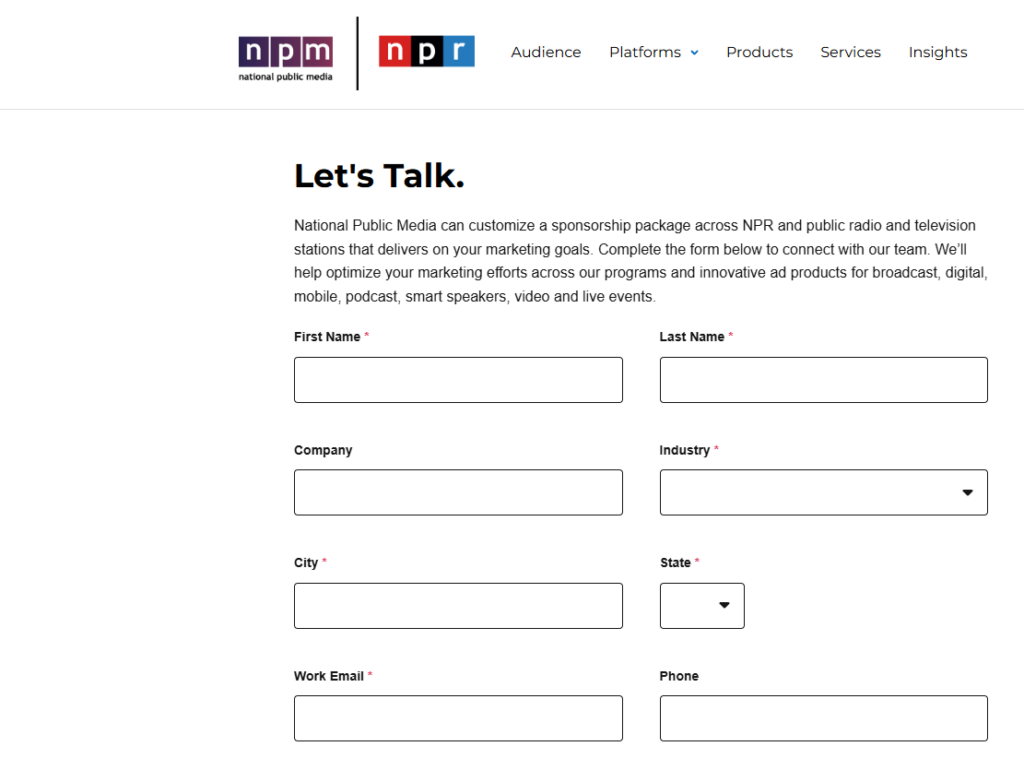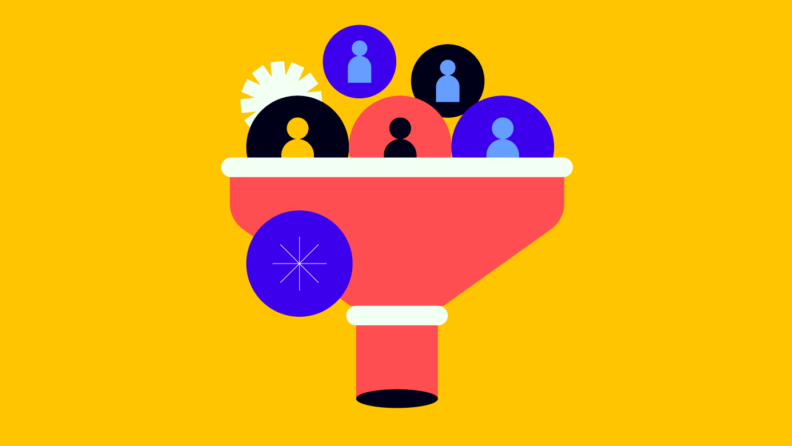Maximize Your ROI: B2B conversion rate optimization allows you to generate more qualified leads and customers without needing a bigger budget or more traffic – just a more refined approach.
AI Can Be Your Best Friend: Use AI-powered tools for predictive analytics, dynamic personalization, and automated A/B testing to drive results.
Personalization Pays Off: Tailor content and offers to your audience’s needs for higher engagement and better conversion rates.
Are you leaving conversions on the table? If you’re not prioritizing conversion rate optimization (CRO), you might be. For B2B marketers, CRO is the key to turning more prospects into customers – without increasing your budget or workload.
Ready to unlock its full potential? This guide will show you how CRO fits into smarter, faster marketing funnel optimization, using strategies, tools, and AI-driven insights to drive real results.
What Is B2B Conversion Rate Optimization (CRO)?
B2B conversion rate optimization (CRO) is a digital marketing strategy that boosts the chances of your target audience completing high-value actions on your website, like filling out forms, booking demos, or downloading resources. Unlike strategies aimed at increasing traffic, CRO focuses on improving the performance of existing web traffic, helping you generate higher-quality leads without extra ad spend.
Why B2B CRO Differs from B2C CRO
Conversion rate optimization requires careful analysis of your target audience, looking for patterns in behavior that result in conversions. Due to this focus on customer behavior, CRO strategies differ between B2C and B2B marketing.
The B2B sales cycle is often longer and more complex than in B2C, involving multiple stakeholders and high-ticket purchases. Unlike B2C buyers, who tend to make more impulse decisions, B2B buying teams take their time, with many waiting until they’re 70% through the buying process before reaching out to sales (6sense, 2023).
Tactics that work well in B2C ecommerce, such as limited-time offers or flash sales, are less likely to hit the mark with B2B buyers. Instead, B2B buyers prioritize trust, value, and long-term ROI. This means your B2B CRO strategies must focus on building credibility, providing value, and nurturing leads over time.
How To Measure B2B Conversion Rates
Step one of CRO is to calculate your conversion rate. Understanding this baseline is necessary to set realistic goals and measure the success of your CRO strategies.
Here’s the formula:
B2B conversion rate (CR) = (desired actions taken / opportunities for desired action to happen) x 100
To use this formula, define the variables based on your B2B business goals, for example:
- Desired actions taken: Number of contact form submissions, demo bookings, or resource downloads.
- Opportunities for desired action to happen: Typically the total number of website visitors, email recipients, or ad impressions.
For instance, if 50 people booked a demo out of 1,000 website visitors, the calculation would be:
CR = (50/1,000) x 100 = 5%
However, your overall conversion rate isn’t the only metric you need to monitor. There are several key metrics to track to measure and improve specific parts of your sales funnel, such as:
- Visitor-to-lead rate: Tracks how well your website turns visitors into leads.
- Lead-to-MQL rate: Measures the percentage of leads that meet your marketing-qualified criteria.
- MQL-to-SQL rate: Measures how many marketing-qualified leads convert into sales-qualified leads.
Regularly monitor these metrics, along with your average conversion rate, to spot bottlenecks in your funnel and focus optimization efforts where they’ll have the most impact.
Psst – want to dive deeper into the metrics that matter most? Check out The CMO’s Guide to Marketing Metrics for a closer look at the numbers driving success.
6 Top B2B Conversion Rate Optimization Strategies
Alright, you understand how to calculate your conversion rate and you have a general sense of your performance. Now, how do you go about improving it? Let’s explore the top strategies for conversion rate optimization.
1. Create High-Impact Landing Pages
One of the best ways to optimize for conversions is through specific, high-impact landing pages, each created with a clear goal and audience in mind. B2B landing page optimization improves the likelihood of conversion by narrowing your focus to specific visitors, addressing their unique pain points, and guiding them toward action.
Tips for crafting high-converting B2B landing pages:
- Make your offer clear and compelling: Avoid confusion by presenting a single, irresistible offer.
- Pull critical elements above the fold: Position key elements like headlines, CTAs, and benefits to be visible without scrolling. Avoid clutter that pushes key content down.
- Showcase social proof and customer authority: Use customer reviews, testimonials, or recognizable logos to build trust.
- Use a strong value proposition: Your headline should convey the primary benefit of your offering.
- Incorporate action-driven CTAs: Use contrasting button designs and colors to grab attention, and use action-oriented language like “Get Started Now” to encourage clicks.
For example, Monday.com’s landing page is a great example of these best practices in action. The headline is short, clear, and compelling, while the supporting copy and checklist emphasize the tool’s primary benefits.
The CTA is centrally placed, uses clear, action-oriented language, and contrasts with the simple page design to grab attention. Finally, social proof and customer authority are highlighted with high-profile company logos strategically positioned just before the fold, reinforcing credibility.
2. Personalize Your User Experience
Seamless, intuitive personalization is key to driving conversions on B2B websites and a core part of B2B CRO. 86% of B2B buyers expect organizations to be well-informed about their personal information, needs, and preferences (Gartner, 2022).
For B2B companies, the goal is strategic personalization, using customer data and web analytics to craft a simple, yet tailored, user experience. Focus on making the user’s journey as relevant and engaging as possible by aligning your content with their specific needs, preferences, and stages in the funnel.
Here’s how to use personalization in B2B CRO:
- Leverage customer data: Use a mix of historical data (e.g., past purchases or site visits) and real-time behavior (e.g., pages viewed or actions taken) to get inside the mind of your target audience.
- Create dynamic landing pages: Tailor landing pages to different buyer personas or stages of the buying journey. For example, a decision-maker might see case studies, while a researcher might get white papers or educational content.
- Use personalization tools: Use platforms like Google Analytics, HubSpot, or Klayviyo to analyze user behavior, create dynamic content, and deliver personalized emails or landing pages at scale.
For example, ConvertFlow uses dynamic content personalization to update landing pages in real-time. Headings automatically adjust to match the visitor’s traffic source, demonstrating how effective personalization should feel seamless.
3. Simplify Your Lead Capture Forms
For B2B buyers, time is a valuable resource, and lengthy or confusing lead capture forms can lower conversion rates. To keep potential leads engaged, it’s essential to minimize friction and make form completion as simple as possible.
Review your lead capture forms to pinpoint areas that can be improved or removed. For example, replacing manual inputs with smart autofill options, such as one-click sign-in via LinkedIn or Google.
Other tips for optimizing lead capture forms:
- Keep it short: Only ask for the information you absolutely need. Focus on essentials like email, company, and job title.
- Use multi-step forms: Break down complex forms into smaller, digestible steps. Start with basic details, and request additional information (company size, address) in later stages to avoid overwhelming visitors.
- Optimize for mobile: Be sure your forms are responsive and mobile-friendly, as 60% of B2B buyers research on mobile (BCG, 2017).
- A/B test your forms: Experiment with different designs, field arrangements, and form lengths to pinpoint what drives the highest completion rates.
Take the case of National Public Radio (NPR), which increased conversion rates by 1485% and lowered its cost per acquisition by switching to multi-step forms. This strategy helped them secure more corporate sponsorships, a key revenue source for the media brand.

4. Use A/B Testing to Ensure Continuous Improvement
A/B testing is one of the most effective methods for B2B conversion rate optimization. It involves comparing two versions of a webpage, form, or email to determine which performs better based on specific KPIs, such as click-through rates or bounce rates.
A/B testing can highlight small adjustments, such as removing a word from a CTA or repositioning a lead capture form, that can significantly boost conversion rates. One study revealed that A/B testing of UX design can raise conversion rates by 400% (Forrester, 2016).
Key elements to test in B2B A/B testing:
- Headlines: Test different headlines to see which grabs attention or communicates value more effectively.
- Call-to-action (CTA) buttons: Experiment with placement, size, color, and wording (e.g., “Get Started Today” vs. “Request a Demo Now”).
- Form lengths: Try shorter forms vs. longer ones to find the optimal balance between lead quality and submission rates.
- Images or videos: Test visuals to identify those that resonate most with your audience.
- Landing page layouts: Compare minimalist designs to more detailed ones to see what works best for your target audience.
Be careful to only test one element at a time. This is necessary to understand which adjustments are driving results. However, you can create multiple variants to test at once. HubSpot demonstrated this by testing four offer page variants, with Variant C generating 1,400 more B2B leads.
5. Use Data Analytics and Heatmaps to Optimize For User Behaviour
Much of the information needed for B2B CRO already exists inside your website analytics, you just need the right tools and tactics to make use of it. Diving into these analytics can reveal how visitors interact with your site, and tactics like heat mapping and session recordings can highlight areas that may be impacting your conversion rates.
Tools like Hotjar and Crazy Egg offer visual insights into where users are clicking, scrolling, or spending time on your pages. Use this data to identify elements that draw attention or those that are being ignored.
Other tips for leveraging data analytics for B2B CRO:
- Segment your traffic: Break down analytics data by audience segments, such as traffic source, device type, or geographic location. This helps to understand how different groups interact with your site.
- Track micro-conversions: Monitor smaller actions users take before the final conversion, like video plays, downloads, or navigation clicks. This can highlight areas where users are engaging well, or where you’re losing them.
- Set up funnel tracking: Use tools like Google Analytics to map out the user journey and identify where users drop off.
- Integrate data from CRM and marketing software: Combine web analytics with CRM data to understand which traffic sources and interactions result in high-quality leads.
For example, with Hotjar, you can generate a heatmap of your homepage or landing page. This will highlight whether critical elements like your CTA button or lead capture form are drawing attention, or where users are dropping off.
6. Use Retargeting and Relevant Content to Nudge Prospects
Some of your hottest leads are those who have already expressed interest in your offers, such as cart abandoners who left their purchase just before checkout. These prospects are standing at the precipice of conversion – they just need a little extra push.
Retargeting ads on social media platforms like LinkedIn or Facebook is a fantastic way to deliver this push. The Google Display Network also allows you to place display ads on thousands of websites, allowing you to re-engage warm leads and guide them back toward conversion
Types of content to use in retargeting campaigns:
- Case studies: Demonstrate how other businesses have achieved success with your solution.
- Testimonials: Build trust by showcasing feedback from satisfied customers.
- Demos or product tours: Offer a sneak peek of how your product works to entice prospects to take the next step.
- Personalized offers: Provide incentives like free trials or exclusive discounts tailored to their industry or needs.
For example, if a prospect visits your pricing page but leaves without converting, you could serve an ad showcasing a short demo video or case study highlighting ROI, just as RollWorks does with their retargeting ads. This provides content relevant to the prospect’s buying stage in order to nudge them towards a purchase.
How To Take Advantage Of AI With B2B Conversion Rate Optimization
AI is transforming how businesses approach conversion rate optimization by making data analysis faster, insights more actionable, and customer experiences highly personalized. Let’s explore key ways AI can enhance your B2B CRO strategy.
1. Predictive Analytics and Data Insights
One of the best benefits of AI is its ability to analyze data at scale, often picking up on trends and behaviors we’d otherwise miss. Predictive analytics tools use AI-powered algorithms to analyze user behavior, such as which pages they view, how they navigate your site, and where they drop off.
This makes it easier to anticipate and reduce conversion bottlenecks, by identifying where high-potential leads drop off in your marketing funnel. For example, if you notice a pattern of users abandoning your demo request form, predictive analytics can flag this issue and suggest optimizations.
Tools like Marketing Evolution (MEVO) and Tableau make it much simpler, and faster, to develop a data-driven CRO strategy. Use this software to address friction points early, ensuring your efforts result in higher conversion rates.
2. Dynamic Content Personalization
Delivering the right message to the right audience at the right time is the goal of marketing personalization, but it’s difficult to strike this balance. AI solves this with dynamic content personalization, which automatically tailors landing pages, emails, and CTAs based on factors like industry, buyer journey stage, or past behavior.
Tools like Dynamic Yield and Adobe Target make this possible, using machine learning to create dynamic landing pages and content for each visitor in real-time. For example, prospects in the research phase might see a white paper, while someone in the decision stage could see vendor comparisons or promotional offers.
By meeting your audience where they are in the buyer journey, AI-powered personalization helps maintain interest and drives higher conversions.
3. AI-Powered A/B and Multivariate Testing
While necessary for conversion optimization, A/B testing can be time-consuming, especially when it comes to multivariate testing. AI-driven A/B testing simplifies and speeds up this process, helping you test more variables in less time.
AI-powered A/B testing platforms, like VWO or Optimizely, use machine learning algorithms to analyze data at scale, generate variations, and identify the top-performing headlines, lead capture forms, and more.
The best part? Generative AI can suggest A/B test ideas for you, streamlining the ideation and setup process. For example, it might recommend tweaking your CTA or swapping out an image based on data from similar campaigns, saving you time and ensuring every adjustment is rooted in data.
4. Customer Segmentation and Targeting with AI
Most marketers understand the importance of customer segmentation, but the challenge lies in ensuring your efforts are both accurate and impactful. AI-based customer segmentation offers a solution to this problem, improving your ability to group prospects based on common behaviors, characteristics, or buying stages.
With the help of AI, customer data is analyzed much faster, and changes can be made based on real-time buyer behavior. This allows for data-driven targeting based on buying intent, engagement scores, or firmographic data.
Tools like HubSpot and Salesforce Einstein automate this process, enhancing organization, efficiency, and customer insights. By tailoring your messaging to each group’s specific needs, you’ll see improved engagement and stronger conversion rates.
5. Chatbots and AI Assistants for Lead Capture
Lead conversion rates are 8X higher when inbound leads are contacted within 5 minutes (InsideSales, 2021). However, reducing the speed to lead remains a challenge for many B2B marketers.
This is where AI chatbots and assistants come in. These conversational tools streamline lead capture by engaging visitors in real-time, answering FAQs, and qualifying prospects before passing them into your pipeline.
AI chatbots for B2B work the same as having a 24/7 sales assistant on your website, and tools like Drift or Intercom can greet visitors, identify their needs, and schedule demos and meetings. Even better is the fact that your team can focus on other important tasks (or sleep) while this occurs.
Plus, chatbots integrate directly with your CRM, ensuring qualified leads are handed off to your sales team instantly, further improving follow-up. The result? More engaged prospects, faster qualification, and higher conversion rates.
Best B2B Conversion Rate Optimization Tools
The right tools can make all the difference when it comes to optimizing your conversion rates. Whether you’re looking to analyze traffic patterns, run sophisticated tests, or personalize content, these tools offer the support you need to improve conversion rates.
Do Less Work for Better Results with CRO
Conversion rate optimization isn’t about working harder, but the opposite: optimizing your approach to turn less into more. The smarter you work, the better your conversion rates will be, which is why it’s important to lean on AI-driven technology and software to support your CRO efforts.
Keep in mind: the faster you can process data, the faster you can turn prospects into high-value customers. With the right tools, strategies, and data-driven insights, you can streamline your marketing efforts, deliver personalized experiences, and drive measurable results.
Join For More Marketing Insights
Ready to grow? Subscribe to The CMO newsletter to stay on top of trends and get the latest tips, resources, and guides from our community of seasoned marketing leaders straight to your inbox.








